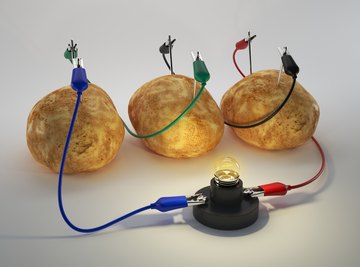
You can build a homemade battery from various parts lying around your house. A simple DIY battery can show you how electricity flows through objects from positive to negative ends of the battery.
You may be surprised how useful your household objects may be in creating something that may initially seem like it can only be created in a factory. Though this method won't be the exact same chemical reactions that go into factory-made batteries, it can show you the power of electricity in general.
Building a Homemade Battery
You can create the basics of a homemade battery using an earth battery, a coin battery or a salt battery. These homemade batteries will use a chemical reaction to create an electric current. You can build this current through basic materials lying in your own home along with an electrolytic solution.
Tips
You can create earth batteries, coin batteries, and salt batteries using the basic principles of electricity through these DIY tutorials.
Use precaution, though. These batteries are small and simple, but avoid touching both wires that connect the ends of the battery at the same time. When cutting wires or testing voltage or current in the current, be extra careful not to either short circuit your battery or to hurt yourself through the electricity or heat.
Earth Battery Preparation
You can make earth batteries from electrodes that are made of metals that can conduct an electric current through each other. These metals can work when they're in the ground itself, giving this type of battery its name. You will need to be outside during a time when there isn't any hazardous weather such as heavy rain or thunderstorms.
You'll also need 12 copper nails (or rods) that will be placed in the ground, 12 galvanized aluminum nails (or rods), copper wire and high value capacitors. In addition, you'll need a voltmeter and wire cutters. You can also optionally use measuring tape, aluminum foil and a compass for more refined calculations when creating your battery.
Before digging in your yard, make sure you have permission from local utilities or others who own the property. For safety reasons, you may even consider only digging a few inches deep.
Making an Earth Battery
To make the earth electrodes, use the wire cutters to remove about 1.5 inches of insulation from the copper wire. Wrap the strips of wire around the aluminum and copper nails. Then, you insert the the electrodes and attach multimeter leads to them. Set the multimeter to either DC or AC depending on current you plan to use.
To create the simplest earth battery, a single-cell kind, you can start by nailing one copper nail and one aluminum nail in the ground several feet apart. Connect them using your copper wire. Make sure that the wire is wound tightly and securely around the heads of each of the nails. Check the multimeter to see if you can read current.
Wrapping aluminum foil tightly around the wires can give you a more thorough way of sending charge between the nails. To create a more complicated, multiple-cell battery, you can use all 12 aluminum and copper cells arranged with one connected to the other in a series circuit alternating between aluminum and copper. Each connected pair of nails is a cell in this case.
Because the power of an earth battery depends upon the ion content of the earth's soil, it only works in some parts of the land. The natural electric currents that flow through the ground from iron and other ionic metals in the ground can create natural electricity.
Building A Coin Battery
Building a coin battery is another straightforward, simple way of demonstrating current and voltage in a battery. For this, you'll need a few copper pennies, a piece of aluminum foil, a piece of wet tissue or cardboard, scissors, salt, a multimeter and a bowl of water. You can also optionally use vinegar as an electrolyte. To ensure the penny is made of copper, make sure it was produced after 1982.
Take the paper towel or wet tissue or cardboard and place the coin on it so you can cut its shape out of the paper towel or wet material. To create the electrolyte, mix a few teaspoons of salt into the bowl of water until it dissolves. If you have vinegar, you can use this as a weak electrolyte.
Dip the wet fabric or tissue into the bowl of the electrolyte and take it out after two minutes. Soak out excess water from it. Wrap one penny in aluminum foil and cut out its shape. Then, you can add the soaked material to the aluminum foil and put the coin on top of it. This is your basic cell of the battery.
Create as many battery cells as you want and stack them on top of one another. You can test to see if your battery is working by hooking a multimeter to both ends or placing a small LED light that will turn on in the presence of electric current. Think about how this arrangement is similar to the multi-cellular arrangement of earth batteries.
Building a Salt Battery
Similar to the coin battery, salt batteries are made with a quarter. This time, you'll need a syringe piston, 12 iron or zinc screws, strips of paper and sandpaper, salt, water, a multimeter, a screwdriver, LED lights, an insulating material like plastic or cardboard and a copper wire. Use the sandpaper to remove the insulation of the copper wire if there is any.
Roll one of the strips of paper around a screw tightly and wind the copper wire around the nail 30 to 40 times for all 12 of your screws. Make sure the copper wire doesn't directly touch the nail, but, rather, rests on the strip of paper.
Use the syringe piston to make six holes on on one side of the insulating material. Use the screwdriver to push each screws through the insulating material in a grid formation. This setup will be the basis of how the electric current flows through the circuit. Connect them using the copper wire secure and tight.
Dip the battery in salt water for a few minutes so that it can conduct electricity. When you remove it from the water bath, you can use a multimeter to check the voltage of the battery.
Applications of These Batteries
Though these experiments are simple and rudimentary, the phenomena that they illustrate could have practical applications in using water for inexpensive, rechargeable batteries in the future. Research on electrolytic material in physics and chemistry can let scientists use saline solutions as the basis for batteries.
The current drawback of using water as an electrolyte for batteries is that it doesn't supply nearly as much voltage as lithium ion cells or similar chemical cells in batteries. Recent research has attempted to overcome this hurdle.
Research at the Swiss Federal Laboratories for Materials Science and Technology recently lead to the discovery that using sodium FSI (sodium bis(fluorosulfonyl)imide) as the basis for saline solution has electrochemical stability of up to 2.6 volts – almost twice as much as that of other aqueous electrolytic fluids. This could lead to inexpensive, safer batteries.
Earth batteries have had considerable historical use. Scottish philosopher Alexander Bain invented the earth battery in 1841 to transform the flow of current, and this invention would later form the basis of telegraph transmission. Further research using earth batteries would lead to greater understandings of the Earth's electric field such as the finding that the Earth's currents flow from south to north.
References
Tips
- Use a voltmeter to measure the strength of your homemade battery.
- To increase the charge produced by the battery, increase the number of pennies and foil slips in the stack.
- Once the paper towel is soaked and the wires are attached, the entire battery can be wrapped in electrical tape if desired, to improve appearance and reduce chance of a short circuit.
Warnings
- Even though the charge produced by your battery is small, it can still deliver an uncomfortable shock. Avoid touching both wires at the same time.
About the Author
S. Hussain Ather is a Master's student in Science Communications the University of California, Santa Cruz. After studying physics and philosophy as an undergraduate at Indiana University-Bloomington, he worked as a scientist at the National Institutes of Health for two years. He primarily performs research in and write about neuroscience and philosophy, however, his interests span ethics, policy, and other areas relevant to science.
